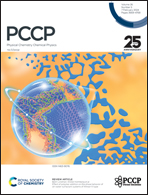Temperature-dependent differential capacitance of an ionic liquid-graphene-based supercapacitor†
Abstract
One of the critical factors affecting the performance of supercapacitors is thermal management. The design of supercapacitors that operate across a broad temperature range and at high charge/discharge rates necessitates understanding the correlation of the molecular characteristics of the device (such as interfacial structure and inter-ionic and ion–electrode interactions) with its macroscopic properties. In this study, we use molecular dynamics (MD) simulations to investigate the influence of Joule heating on the structure and dynamics of the ionic liquid (IL)/graphite-based supercapacitors. The temperature-dependent electrical double layer (EDL) and differential capacitance–potential (CD–V) curves of two different ([Bmim][BF4] and [Bmim][PF6]) IL-graphene pairs were studied under various thermal gradients. For the [Bmim][BF4] system, the differential capacitance curves transition from ‘U’ to bell shape under an applied thermal gradient (∇T) in the range from 3.3 K nm−1 to 16.7 K nm−1. Whereas in [Bmim][PF6], we find a positive dependence of differential capacitance with ∇T with a U-shaped CD–V curve. We examine changes in the EDL structure and screening potential (ϕ(z)) as a function of ∇T and correlate them with the trends observed in the CD–V curve. The identified correlation between the interfacial charge density and differential capacitance with thermal gradient would be helpful for the molecular design of the IL-electrode interface in supercapacitors or other chemical engineering applications.



 Please wait while we load your content...
Please wait while we load your content...